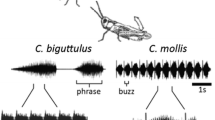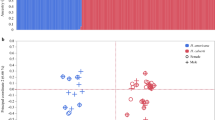Abstract
Most species pairs are isolated through the collective action of a suite of barriers. Recent work has shown that cryptic barriers such as conspecific sperm precedence can be quite strong, suggesting that they evolve quickly. However, because the strength of multiple barriers has been formally quantified in very few systems, the relative speed with which conspecific sperm precedence evolves remains unclear. Here, we measure the strength of both conspecific sperm precedence and cryptic non-competitive isolation between the hybridizing sister species, Chrysochus auratus and C. cobaltinus (Coleoptera: Chrysomelidae), and compare the strength of those barriers to the strength of other known reproductive barriers in this system. Overall, cryptic barriers in this system are weaker than other barriers, indicating that they have not evolved rapidly. Furthermore, their evolution has been asymmetric. Non-competitive barriers substantially reduce the production of hybrid offspring by C. auratus females but not by C. cobaltinus females. In multiply-mated C. cobaltinus females, heterospecific sperm outcompete conspecific sperm, as evidenced by the fact that heterospecific males sired disproportionately more offspring than predicted from the results for singly-mated females. In C. auratus females, neither sperm type has a competitive advantage. Such asymmetries explain why nearly all F1 hybrids in the field are from crosses between C. cobaltinus females and C. auratus males. We discuss these findings in terms of understanding the cost of mating ‘mistakes’ in the Chrysochus hybrid zone. In addition, our discovery that 95% confidence intervals for commonly-used isolation statistics can be very wide has important implications for speciation research. Specifically, to avoid biases in the interpretation of such isolation metrics, we suggest that studies should routinely include error estimates in their analyses of reproductive isolation.





Similar content being viewed by others
References
Aldridge G, Campbell DR (2006) Asymmetrical pollen success in Ipomopsis (Polemoniaceae) contact sites. Am J Bot 93:903–909
Andres JA, Maroja LS, Bogdanowicz SM, Swanson WJ, Harrison RG (2006) Molecular evolution of seminal proteins in field crickets. Mol Biol Evol 23:1574–1584
Barton NH, Hewitt GM (1985) Analysis of hybrid zones. Annu Rev Ecol Syst 16:113–148
Chang A (2004) Conspecific sperm precedence in sister species of Drosophila with overlapping ranges. Evolution 58:781–789
Civetta A, Rosing KR, Fisher JH (2008) Differences in sperm competition and sperm competition avoidance in Drosophila melanogaster. Anim Behav 75:1739–1746
Coyne JA (1992) Genetics and speciation. Nature 355:511–515
Coyne JA, Orr HA (2004) Speciation. Sinauer Associates, Sunderland
Dickinson JL (1995) Trade-offs between postcopulatory riding and mate location in the blue milkweed beetle. Behav Ecol 6:280–286
Dixon SM, Coyne JA, Noor MAF (2003) The evolution of conspecific sperm precedence in Drosophila. Mol Ecol 12:1179–1184
Dobler S, Farrell BD (1999) Host use evolution in Chrysochus milkweed beetles: evidence from behaviour, population genetics and phylogeny. Mol Ecol 8:1297–1307
Dobzhansky T (1940) Speciation as a stage in evolutionary divergence. Am Nat 74:312–321
Eberhard WG (2009) Postcopulatory sexual selection: Darwin’s omission and its consequences. Proc Natl Acad Sci (USA) 106:10025–10032
Fricke C, Arnqvist G (2004a) Conspecific sperm precedence in flour beetles. Anim Behav 67:729–732
Fricke C, Arnqvist G (2004b) Divergence in replicated phylogenies: the evolution of partial post-mating prezygotic isolation in bean weevils. J Evol Biol 17:1345–1354
Gilchrist AS, Partridge L (1997) Heritability of pre-adult viability differences can explain apparent heritability of sperm displacement ability in Drosophila melanogaster. Proc R Soc Lond Ser B 269:1701–1707
Gregory PG, Howard DJ (1994) A post-insemination barrier to fertilization isolates two closely related ground crickets. Evolution 48:705–710
Harrison RG (1983) Barriers to gene exchange between closely related cricket species. I. Laboratory hybridization studies. Evolution 37:245–251
Harrison RG (1990) Hybrid zones: windows on evolutionary process. In: Futuyma DJ, Antonovics J (eds) Oxford surveys in evolutionary biology, vol 7. Oxford University Press, Oxford, pp 69–128
Harrison RG (1998) Linking evolutionary pattern and process: the relevance of species concepts for the study of speciation. In: Howard DJ, Berlocher SH (eds) Endless forms: species and speciation. Oxford University Press, Oxford, pp 19–31
Hebert PDN, Beaton MJ (1993) Methodologies for allozyme analysis using cellulose acetate electrophoresis. Helena Laboratories, Beaumont
Hewitt GM, Mason P, Nichols RA (1989) Sperm precedence and homogamy across a hybrid zone in the alpine grasshopper Podisma pedestris. Heredity 62:343–353
Howard DJ (1999) Conspecific sperm and pollen precedence and speciation. Annu Rev Ecol Syst 30:109–132
Howard DJ, Gregory PG (1993) Post-insemination signalling systems and reinforcement. Philos Trans R Soc Lond B 340:231–236
Howard DJ, Gregory PG, Chu J, Cain ML (1998) Conspecific sperm precedence is an effective barrier to hybridization between closely related species. Evolution 52:511–516
Kay KM (2006) Reproductive isolation between two closely related hummingbird-pollinated neotropical gingers. Evolution 60:538–552
Lee Y-H, Vacquier VD (1992) The divergence of species-specific abalone sperm lysins is promoted by positive Darwinian selection. Biol Bull 182:97–104
Lessios HA, Cunningham CW (1990) Gametic incompatibility between species of the sea urchin Echinometra on the two sides of the isthmus of Panama. Evolution 44:933–941
Lorch PD, Servedio MR (2007) The evolution of conspecific gamete precedence and its effect on reinforcement. J Evol Biol 20:937–949
Lowry DB, Rockwood RC, Willis JH (2008a) Ecological reproductive isolation of coast and inland races of Mimulus guttatus. Evolution 62:2196–2214
Lowry DB, Modliszewski JL, Wright KM, Wu CA, Willis JH (2008b) The strength and genetic basis of reproductive isolating barriers in flowering plants. Phil Trans R Soc Lond B 363:3009–3021
Markow TA (1997) Assortative fertilization in Drosophila. Proc Natl Acad Sci (USA) 94:7756–7760
Marshall JL, Arnold ML, Howard DJ (2002) Reinforcement: the road not taken. Trends Ecol Evol 17:558–563
Martin NH, Willis JW (2007) Ecological divergence associated with mating system causes nearly complete reproductive isolation between sympatric Mimulus species. Evolution 61:68–82
Martin-Coello J, Benavent-Corai J, Roldan ERS, Gomendio M (2009) Sperm competition promotes asymmetries in reproductive barriers between closely related species. Evolution 63:613–623
Matsubayashi KW, Katakura H (2009) Contribution of multiple isolating barriers to reproductive isolation between a pair of phytophagous ladybird beetles. Evolution 63:2563–2580
Mayr E (1947) Ecological factors in speciation. Evolution 1:263–288
Mendelson TC, Imhoff VE, Venditti JJ (2007) The accumulation of reproductive barriers during speciation: postmating barriers in two behaviorally isolated species of darters (Percidae: Etheostoma). Evolution 61:2596–2606
Metz EC, Palumbi SR (1996) Positive selection and sequence rearrangements generate extensive polymorphism in the gamete recognition protein binding. Mol Biol Evol 13:397–406
Monsen KJ, Honchak BM, Locke SE, Peterson MA (2007) Cytonuclear disequilibria in Chrysochus hybrids is not due to patterns of mate choice. J Hered 98:325–330
Nosil P (2007) Divergent host plant adaptation and reproductive isolation between ecotypes of Timema cristinae walking sticks. Am Nat 169:151–162
Nosil P, Crespi BJ (2006) Ecological divergence promotes the evolution of cryptic reproductive isolation. Proc R Soc Lond Ser B 273:991–997
Nosil P, Vines TH, Funk DJ (2005) Perspective: reproductive isolation caused by natural selection against immigrants from divergent habitats. Evolution 59:705–719
Palumbi SR, Metz RC (1991) Strong reproductive isolation between closely related tropical sea urchins (genus Echinometra). Mol Biol Evol 8:227–239
Peterson MA, Dobler S, Holland J, Tantalo L, Locke S (2001) Behavioral, molecular, and morphological evidence for a hybrid zone between Chrysochus auratus and C. cobaltinus (Coleoptera: Chrysomelidae). Ann Entomol Soc Am 94:1–9
Peterson MA, Monsen K, Pedersen H, Bearden J, McFarland T (2005a) Direct and indirect evidence of low hybrid fitness in the Chrysochus hybrid zone. Biol J Linn Soc 84:273–286
Peterson MA, Honchak B, Locke S, Beeman T, Mendoza J, Green J, Buckingham K, White MA, Monsen K (2005b) Relative abundance and the species-specific reinforcement of male mating preference in the Chrysochus (Coleoptera: Chrysomelidae) hybrid zone. Evolution 59:2639–2655
Peterson MA, Dobler S, Larson EL, Juárez D, Schlarbaum T, Monsen KJ, Francke W (2007) Profiles of cuticular hydrocarbons mediate male mate choice and sexual isolation between hybridising Chrysochus (Coleoptera: Chrysomelidae). Chemoecology 17:87–96
Price CSC (1997) Conspecific sperm precedence in Drosophila. Nature 388:663–666
Price CSC, Kim CH, Posluszny J, Coyne JA (2000) Mechanisms of conspecific sperm precedence in Drosophila. Evolution 54:2028–2037
Price CSC, Kim CH, Gronlund CJ, Coyne JA (2001) Cryptic reproductive isolation in the Drosophila simulans species complex. Evolution 55:81–92
R Development Core Team (2009) R: a language and environment for statistical computing. R Foundation for Statistical Computing, Vienna
Rahmé J, Widmer A, Karrenberg S (2009) Pollen competition as an asymmetric reproductive barrier between two closely related Silene species. J Evol Biol 22:1937–1943
Ramsey J, Bradshaw HD Jr, Schemske DW (2003) Components of reproductive isolation between the monkeyflowers Mimulus lewisii and M. cardinalis (Phrymaceae). Evolution 57:1520–1534
Richardson BJ, Baverstock PR, Adams M (1986) Allozyme electrophoresis: a handbook for animal systematics and population studies. Academic Press, Sydney
Rieseberg LH, Desrochers AM, Youn SJ (1995) Interspecific pollen competition as a reproductive barrier between sympatric species of Helianthus (Asteraceae). Am J Bot 82:515–519
Schwander T, Suni SS, Cahan SH, Keller L (2008) Mechanisms of reproductive isolation between an ant species of hybrid origin and one of its parents. Evolution 62:1635–1643
Schwartz S, Peterson MA (2006) Strong material benefits and no longevity cost of multiple mating in an extremely polyandrous beetle. Behav Ecol 17:1004–1010
Servedio MR, Noor MAF (2003) The role of reinforcement in speciation: theory and data meet. Annu Rev Ecol Evol Syst 34:339–364
Snook RR, Chapman T, Moore PJ, Wedell N, Crudgington HS (2009) Interactions between the sexes: new perspectives on sexual selection and reproductive isolation. Evol Ecol 23:71–91
Sobel JM, Chen GF, Watt LR, Schemske DW (2010) The biology of speciation. Evolution 64:295–315
Sokal RR, Rohlf FJ (1981) Biometry, 2nd edn. Freeman, New York
SPSS (2005) SPSS 11.0.4 for Mac OS X. SPSS Inc, Chicago
Swanson WJ, Clark AG, Waldrip-Dail HM, Wolfner MF, Aquadro CF (2001) Evolutionary EST analysis identifies rapidly evolving male reproductive proteins in Drosophila. Proc Natl Acad Sci (USA) 95:4051–4054
Takami Y, Nagata N, Sasabe M, Sota T (2007) Asymmetry in reproductive isolation and its effect on directional mitochondrial introgression in the parapatric ground beetles Carabus yamato and C. albrechti. Popul Ecol 49:337–346
Turelli M, Moyle LC (2007) Asymmetric postmating isolation: Darwin’s corollary to Haldane’s rule. Genetics 176:1059–1088
Wu CI, Hollocher H, Begun DJ, Aquadro CF, Xu Y, Wu M-L (1995) Sexual isolation in Drosophila melanogaster: a possible case of incipient speciation. Proc Natl Acad Sci (USA) 92:2519–2523
Acknowledgments
This work would not have been possible without the assistance of many others, both in the lab and the field, to whom we are grateful. In particular, Timm Beeman, Tyler Bourcier, Monique Brewer, Jabin Green, Liam Hahn, Karina Helm, Barb Honchak, Stefanie Locke, Tracy McFarland, Jessica Mendoza, Meaghan McNeal, Amy Savage, Steven Schwartz, Erik Walker, and Carol Yoon helped collect virgin beetles, perform crosses, and conduct beetle husbandry. In addition, Jillian Bearden, Erin Beardsley, Theresa Black, Barb Honchak, Hallie Kerins, Flordeliza Lilagan, and Joe Skillman assisted with larval genotyping. We are also grateful to Ben Miner for help with the bootstrap analysis, and Doug Schemske and Carol Yoon for stimulating discussions on the ideas discussed herein. Funding for this research was provided by the Biology Department and Office of Research and Sponsored Programs at Western Washington University and the National Science Foundation (DEB-0212652), including supplemental National Science Foundation funding to establish a summer internship, Minority Opportunities for Research on Evolution, in which several of this paper’s coauthors participated. Finally, the first two authors, both of whom have had the privilege of working under the advisement of Rick Harrison, thank Rick for the inspiration to conduct research in hybrid zones and for his unflagging support and encouragement.
Author information
Authors and Affiliations
Corresponding author
Rights and permissions
About this article
Cite this article
Peterson, M.A., Larson, E.L., Brassil, M. et al. Cryptic gametic interactions confer both conspecific and heterospecific advantages in the Chrysochus (Coleoptera: Chrysomelidae) hybrid zone. Genetica 139, 663–676 (2011). https://doi.org/10.1007/s10709-011-9567-z
Received:
Accepted:
Published:
Issue Date:
DOI: https://doi.org/10.1007/s10709-011-9567-z




